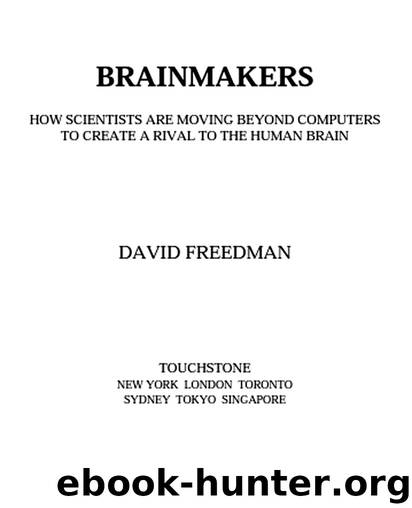BRAINMAKERS by DAVID FREEDMAN

Author:DAVID FREEDMAN
Language: eng
Format: epub
Publisher: TOUCHSTONE
Published: 1994-07-15T00:00:00+00:00
For the most part it is eliciting more puzzlement than fear [in the United States]. Indeed, some computer scientists say the new project shows that [Japan’s ] vaunted system of Government-led industrial development is running out of steam, at least in electronics, just at a time when other nations are thinking of emulating Japan.
What’s more, the U.S. government loudly complained ten years ago that the Fifth Generation Project was excluding U.S. researchers; the formation in the mid-1980s of MCC and Lenat’s Cyc project was a product of the government’s concern. But this time around the government has actually encouraged researchers to turn down Japan’s enthusiastic invitations to participate in the Sixth Generation, claiming Japanese laws do not offer adequate protection over intellectual property.
Why so blasé this time around? Part of the reason may be that conventional AI researchers are still the big guns when it comes to influencing research, and many of them are no more interested in seeing money poured into neural networks now than they were to see it poured into perceptrons in the 1960s and 1970s. But in addition, even among many U.S. neural network researchers there is a hint of derision toward the Japanese enthusiasm for achieving brain-like devices. The fact is, when Japanese researchers gush about constructing human brains, they sound a little silly. On the other hand, they probably don’t sound a lot sillier than the Japanese automakers did to their U.S. counterparts in the early 1970s when they emphasized practical, high-quality, fuel-efficient cars.
Shun-ichi Amari, a highly respected University of Tokyo researcher and chairman of the planning committee for the Sixth Generation Project, is sitting in a lounge of the New Otani hotel just before delivering the opening speech to the first official meeting of the undertaking. Amari seems anything but naive about the task ahead. “The human brain is the most complex thing mankind has ever tried to study,” he says. “Duplicating it may be impossible. But we think that with enough effort, we can put together pieces of the picture that will open up new generations in computing.”
Some of the pieces undertaken by Japanese scientists seem like solid neural network research embellished with a fanciful twist. Mitsuo Kawato at the Advanced Telephony Research Labs (Japan’s Bell Labs), for example, states up front that he wants to build a robotic “secretary” within ten years. “It will have a fax and a telephone, and it will know how to keep out of your way,” he explains. Kawato’s robosecretary will also know how to speak naturally, if his research pays off; he and associates have taken detailed measurements of the velocity and acceleration of twelve different muscles around the human mouth and throat as they articulate various sounds, and have applied these data to a neural-network-controlled audio system.
And even if the robosecretary doesn’t get out of the way fast enough, it shouldn’t cause any serious problems: Kawato’s group has developed a neural-network-based robot arm that, in imitation of the human arm, incorporates two opposing sets of hydraulic “muscles.
Download
This site does not store any files on its server. We only index and link to content provided by other sites. Please contact the content providers to delete copyright contents if any and email us, we'll remove relevant links or contents immediately.
Algorithms of the Intelligent Web by Haralambos Marmanis;Dmitry Babenko(8523)
Test-Driven Development with Java by Alan Mellor(7428)
Data Augmentation with Python by Duc Haba(7318)
Principles of Data Fabric by Sonia Mezzetta(7065)
Learn Blender Simulations the Right Way by Stephen Pearson(7007)
Microservices with Spring Boot 3 and Spring Cloud by Magnus Larsson(6825)
RPA Solution Architect's Handbook by Sachin Sahgal(6236)
Hadoop in Practice by Alex Holmes(6032)
The Infinite Retina by Robert Scoble Irena Cronin(5936)
Jquery UI in Action : Master the concepts Of Jquery UI: A Step By Step Approach by ANMOL GOYAL(5873)
Big Data Analysis with Python by Ivan Marin(5732)
Life 3.0: Being Human in the Age of Artificial Intelligence by Tegmark Max(5405)
Pretrain Vision and Large Language Models in Python by Emily Webber(4693)
Infrastructure as Code for Beginners by Russ McKendrick(4471)
WordPress Plugin Development Cookbook by Yannick Lefebvre(4205)
Functional Programming in JavaScript by Mantyla Dan(4124)
The Age of Surveillance Capitalism by Shoshana Zuboff(4118)
Embracing Microservices Design by Ovais Mehboob Ahmed Khan Nabil Siddiqui and Timothy Oleson(3996)
Applied Machine Learning for Healthcare and Life Sciences Using AWS by Ujjwal Ratan(3972)
